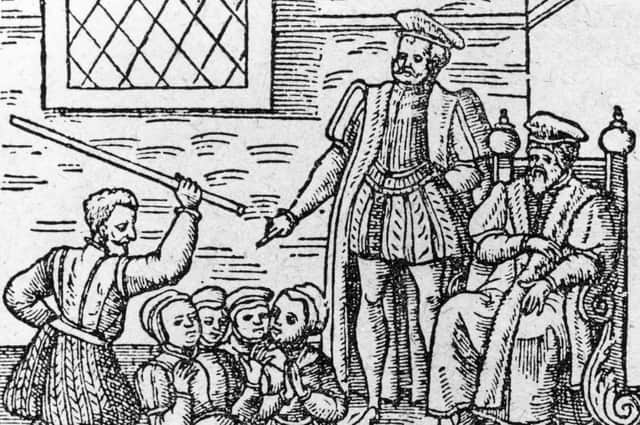The lessons we can still learn from the witch hunt frenzies of the past - Susan Morrison


It's nearly Hallowe’en. Time for one last visit to the season of the witch to ask how it finally ended, and did they leave a legacy beyond kids in costumes and the Americanised Trick or Treat?
Physically, they left little.
Only one confessed witch has a grave. Lilias Adie, buried in the sands at Torryburn under a weighty stone. Sensible precautions to stop her emerging from her sandy tomb and terrorising the village as a revenant. As it happens, she didn’t rest in peace. Her skull was dug up for a collector. It was photographed, measured and examined, then lost.
Advertisement
Hide AdAdvertisement
Hide AdBy the time Lilias was accused in 1704 the day of the witch hunter was coming to an end. The last execution was in 1727, the same year they founded the Royal Bank of Scotland. By 1735, the Witchcraft Act was gone. Enlightenment thinking was seeping into Scotland, and the men of learning looked askance at dodgy testimonies obtained under torture of flying horses and devilish encounters, all carefully written down by the clerks of the court.
Witch hunting was nothing if not bureaucratic. Scottish witches were not lynched. The full power and machinery of the law was brought to bear. Testimonies were gathered and interrogations carried out. Accused witches were heard before a court, with lawyers, magistrates and baillies all in attendance. All this was also recorded.
When the guilty verdict came in, the sentence had to be carried out. It’s not an easy thing to burn a human body. It needs a lot of fuel. All that wood has to be sourced and stored before execution, then fired. That’s a valuable resource literally going up in flames.
The kirk and state worked hand-in-hand to legally deal with the Devil, and made sure they left the correct paperwork. It’s a mind-boggling level of pen-pushing.
In these pages we catch glimpses of the tininess of life in 16th and 17th century Scotland. People snarking at each other over livestock and land, worries about children's health and money.
Theoretically, once they’d put their “hands on the crown of my head and the other to the sole of my foot and renounced all between my two hands to the Devil” and sold their souls, you’d expect them to use their demonic powers to suddenly acquire great wealth or fancy homes.
They don’t. They steal corn and kill neighbours they’ve had a grudge against.
This was what they knew. They could only talk about what they could see. There are tales of vengeance, dodgy cures and dancing in kirkyards. They could only ask for better versions of what they knew. There’s a yearning for a bit more good food and decent drink. Isobel Goudie isn’t the only witch to talk about feasting with the Queen of the Fairies, who comes across as a mean girl given to pranks and dishing out bad advice.
Advertisement
Hide AdAdvertisement
Hide AdThese are people living in a fearful world. Death is sudden. Cows dry. Plague appears. Explanations are sought, no matter how outlandish. If your third baby has just died, you’ll believe that witches such Janet Broadhead conspired with her coven, creating an effigy with “head, face, eyes, nose, mouth, lips…to be used in rituals” until “the bairn died”.
We blink at that today, but we can be just as gullible. The pandemic ignited a bin fire of conspiracy theories hot enough to warm Satan’s cold heart.
There was no virus, they said. 5G mobile signals caused it. It wasn’t that bad. It was a government plot to keep us in our houses.
Like the accused witches, today’s rumour mongers tend to tell their tales about things they can see. When the vaccines arrived they said they were dangerous. There were microchips in it to monitor our every move. It was just a fake.
Sickness remains a good breeding ground for those who weave charms and spells. Sixteenth century women with sick babies would beg useless cures from the Queen of the Fairies. Today she’d be a wellness influencer, complete with her own YouTube channel to flog her snake-oil supplements.
The witch hunts have never really gone away. We don’t burn the accused any more, but even today, people who speak out of line can see their careers go up in flames, particularly women. And just as the Queen of the Fairies could shape-shift today into a clean-eating colonic-irrigator, the witch hunt has been twisted around to be used, most surprisingly, by powerful men.
Donald Trump, despite the mountains of evidence against him, constantly screams witch hunt. It’s tempting to wonder if his Scottish mother ever told him what it really meant to be accused of witchcraft.
Boris Johnson’s allies shrieked about a ‘witch hunt’, despite the detailed investigations proving that their man was a bad ‘un. What would Mr Trump and Mr Johnson have sold their souls for?
Advertisement
Hide AdAdvertisement
Hide AdIn Scotland we didn’t really talk about the years of the witch for a long time. We left it to folklore and telling scary stories. At last historians like Julian Goodaire, Louise Yeoman and Lizanne Henderson, to name just a few, have opened up the records to present the truth about the accused.
If you want to be a modern witch hunter, they’ve helped create fantastic sources online, chief amongst them the interactive witch map of Scotland.
Lillias is only one of those thousands of women and men that we can see, thanks to Dr Christopher Rynn from Dundee's Centre for Anatomy and Human Identification Centre. At least we can look at a face when we say sorry.
It's time for a memorial, and even more research, to truly remember what really happened when the witch frenzy hit us. That may be their only legacy.
Comments
Want to join the conversation? Please or to comment on this article.